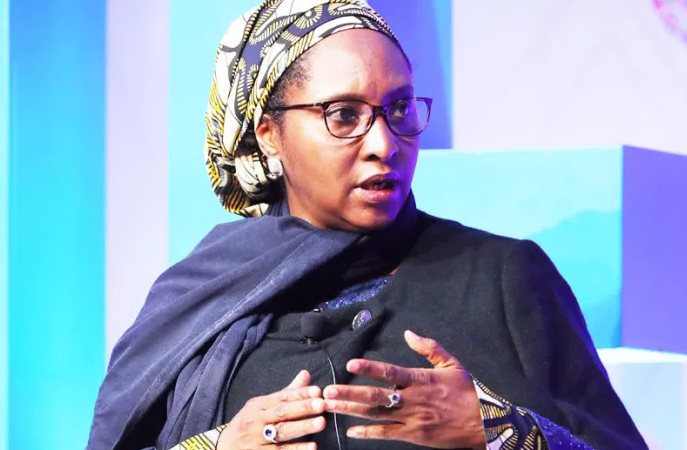FG Owed N5.2trn, Says Ahmed, Orders FGOEs, MDAs To Update Debtors’ List On Monthly Basis

The Minister of Finance, Budget and National Planning, Mrs. Zainab Ahmed yesterday revealed that the federal government was being owed approximately N5.2 trillion.
She therefore directed all Federal Government Owned Enterprises (FGOEs) and ministries, departments and agencies (MDAs) to henceforth update their list of debtors on a monthly basis against the ‘Project Lighthouse’ debt recovery portfolio.
‘Project Lighthouse’ is a data-driven artificial intelligence engine which provides the Ministry of Finance, Budget and National Planning with an intelligence and profiling platform to aid in policy formulation, implementation and assessing the impacts of those policies which would support its MDAs to develop a more efficient revenue assessment methodology by ensuring that major revenue loopholes are plugged, and revenue collection is dramatically improved.
Ahmed, who spoke during the launch of the Project Lighthouse Data Analytics and Reporting Platform in Abuja, yesterday stated that going by data aggregated from over 5,000 debtors across ten MDAs, the federal government is being owed approximately N5.2 trillion.
The minister disclosed that in collaboration with the Office of the Accountant General of the Federation (OAGF), the sum of N53.5 billion had been recovered within the last 12-18 months, through the Government Integrated Financial Management Information System (GIFMIS) as a recovery touch point.
According to her, a perfunctory review of perceived significant leakages in government led her ministry to issue a directive on September 26, 2019, to all government agencies in a bid to aggregate all government debts across all MDAs, with a view to having a single window on the credit profile of government.
The minister said,
Sequel to the issuance of the Finance Circular, the ministry through the consolidation efforts of the project, has been able to aggregate monumental debts of approximately N5.2 trillion.
These debts came to the spotlight from data aggregated from over 5,000+ debtors across ten (10) Ministries, Departments and Agencies (MDAs).
Working in collaboration with the Office of the Accountant General of the Federation (OAGF), we have been able to recover the sum of N53.5 billion within the last 12-18 months, through the Government Integrated Financial Management Information System (GIFMIS) as a recovery touch point.
However, to consolidate on the current effort of this project, a Debt Recovery Application has been built to be monitored by the new Debt Recovery Unit.
The Debt Recovery Unit will capitalise on the effort made by the project consultants to provide the government with up-to-date records into its credit status by harmonising debt records across all MDAs within the country, give debtors access to a platform to view and offset debt in a seamless and secured manner as well as strengthen the institutional framework for enforcement and management of the Federal Debt Recovery plan.
She stated that the main capabilities of the Project Lighthouse Debt Recovery Application are to create users and their usage profiles to allow owners/representatives of registered companies with the Corporate Affairs Commission (CAC), sign up on the system and ascertain the status of their liabilities to the government.
It is also to be used by debtors to offset debt in a seamless and secured manner, as well as to be used by the Federal Ministry of Finance, Budget and National Planning (FMFBNP) to track the credit profile of the government, ascertain details of outstanding amount due and amount recovered from debtors.
It also gives Ministries, Departments and Agencies (MDAs) access to update debt records progressively.
In addition to this, a fully functional website has been developed to effectively manage public perception around the Government debt recovery efforts and revenue improvement strategies.
I want to use the opportunity to urge all FGOEs and MDAs to update their list of debtors on a month-on-month basis against the Project Lighthouse debt recovery portfolio.
This also encompasses the development of an institutional framework for enforcement, recovery and management of the fiscal environment,
Ahmed said.
She recalled that one of the key economic policy objectives of the current administration, as contained in the Economic Recovery and Growth Plan (ERGP), is improving overall federal government revenues by targeting and increasing revenues from non-oil sources. ERGP, Ahmed added also aimed, among other goals, to increase the tax base by drastically increasing the Company Income Tax and Value Added Tax compliance, bringing additional taxpayers into the tax net, and increase Tax to GDP ratio.
You will recall that in the last few months, major steps have been taken to improve the fiscal position of government. One of such steps is the implementation of quite a number of portfolio initiatives under the Strategic Revenue Growth Initiatives (SRGI), which some of you have been participating in.
Despite the fact that we live in a technology and data-centric world, we have not had a culture of using data and information to guide the formulation, implementation and impact assessment of our initiatives and policies or even in carrying out our mandate as a ministry.
This modus operadis presents a number of challenges. First, our policies are not usually empirically based. Second, we are not able to effectively track the implementation and impact of these policies, initiatives, programmes and mandate. Third, we lack data to help guide the revision or optimisation of these policies,
the minister said.
In response to the aforementioned challenges, she stated that her ministry initiated “Project Lighthouse”, stressing that in July 2017 during the first phase of Project Lighthouse, data was mined from multiple sources to support the implementation of the Voluntary Assets and Income Declaration Scheme (VAIDS).
Such data, she said, included tax records from tax authorities, company ownership and directors from Corporate Affairs Commission (CAC), land records from land registries, Company directors’ information from the National Insurance Commission (NAICOM), Asset Management Corporation of Nigeria (AMCON), Non-structured data from online sources, contractor payment records from GIFMIS, and Remita, among others.

Justin Nwosu is the founder and publisher of Flavision. His core interest is in writing unbiased news about Nigeria in particular and Africa in general. He’s a strong adherent of investigative journalism, with a bent on exposing corruption, abuse of power and societal ills.













